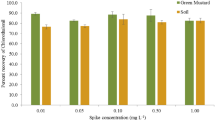Abstract
The Agricultural Reentry Task Force (ARTF) conducted a study to determine whether different dislodgeable foliar residue (DFR) techniques had any effect on the amount of residues dislodged from the leaves of vegetable crops. Four previously employed techniques were evaluated with two chemicals (carbaryl and methomyl) on two crops (cabbage and lettuce). Carbaryl, a moderately water-soluble chemical, was applied at a rate of 2.0 lbs active ingredient/acre (lb ai/A) while methomyl, a highly water soluble chemical, was applied at a rate of 0.9 lb ai/A. One day after application, leaf punches were collected and the residues were dislodged following one of four techniques that differed in the number of dislodgings per sample, the duration of dislodging, the solution volume, and/or the type of solution used. The results indicated that three of the techniques gave similar results, whereas a fourth gave marginally lower results.

Similar content being viewed by others
References
Korpalski S, Bruce E, Holden L, Klonne D (2005) Dislodgeable foliar residues are lognormally distributed for agricultural reentry studies. J Expos Anal Environ Epidemiol 15:160–163
Littell RC, Milliken GA, Stroup WW, Wolfinger RD (1996) SAS® system for mixed models. SAS Institute Inc., Cary, North Carolina
SAS (1999) SAS/STAT® user’s guide, version 8, volumes 1–3. SAS Institute Inc., Cary, North Carolina
SAS (2000) SAS OnlineDoc® HTML Format, Version 8, SAS Institute Inc., Cary, NC
Tomlin CDS (ed) (1997) The pesticide manual: A world compendium. 11th edition. British Crop Protection Council, Farnham, Surrey, UK
USEPA. Data call-in notice 18-Oct-1995, as amended 10-Jan-1997; copied to registrants of specific PC coded pesticide products
USEPA (2000) Agricultural transfer coefficients. Science Advisory Council for Exposure, policy number 003.1, 7 August, 2000
Acknowledgments
The ARTF is deeply indebted to the many people who have served on both its administrative and technical committees of the ARTF over the last 7 years. Only through the dedication of such individuals, as well as the commitment of the member companies in allowing their employees to dedicate the time and effort required for such a massive, long-term project, could it have been successfully completed. The product of their labors will be a cornerstone of agricultural reentry risk assessments for many years to come.
Author information
Authors and Affiliations
Corresponding author
Rights and permissions
About this article
Cite this article
Bruce, E., Korpalski, S., Johnson, D. et al. Effect of Dislodging Techniques on Foliar Residue Determination for Agricultural Crops. Arch Environ Contam Toxicol 50, 138–143 (2006). https://doi.org/10.1007/s00244-005-7041-6
Received:
Accepted:
Published:
Issue Date:
DOI: https://doi.org/10.1007/s00244-005-7041-6




